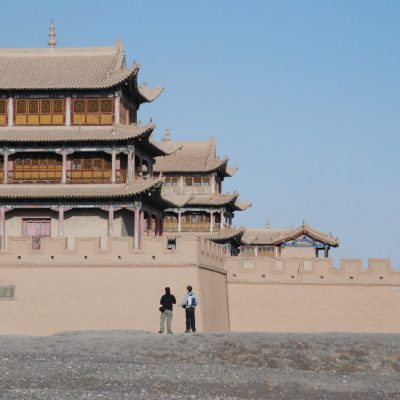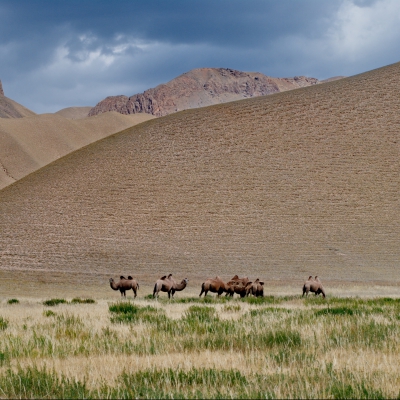Kirgisistan (oft auch Kirgistan oder Kirgisien, Kirgisische Republik) ist ein zentralasiatischer Binnenstaat mit rund 5,5 Millionen Einwohnern. Er grenzt im Norden an Kasachstan (1113 km), im Südosten an China (1048 km), im Süden an Tadschikistan (972 km) und im Westen an Usbekistan (1374 km). Hauptstadt ist Bischkek.
Der Name qirqiz oder kyrgyz stammt vermutlich aus dem 8. Jahrhundert n. Chr. Die heutigen Kirgisen stammen ursprünglich aus dem sibirischen Jenissei-Tal, von wo aus sie als Folge der Ausbreitung der Mongolen in das heutige Siedlungsgebiet wanderten. Die Kirgisen glauben, dass ihr Volksname vom Begriff kirkkyz („vierzig Mädchen“) abstammt und sie selbst Nachfahren von 40 Stämmen seien.
Geographie
Der gebirgige Binnenstaat Kirgisistan hat eine Landesfläche von ca. 200.000 km² und etwa 5,5 Millionen Einwohner. Kirgisistan liegt im Hochgebirge des Tianshans und erreicht mit dem 7439 m hohen Pobeda Pik die größte Höhe. 94 % der Landesfläche sind gebirgig, nur auf 20 % der Fläche ist das Betreiben von Landwirtschaft möglich. Geologisch ist der Tienshan ein junges Gebirge, weshalb die Berge in Kirgisistan dominant und schroff aufragen und sich Täler tief einschneiden. Die Bevölkerung konzentriert sich vor allem im Tschüital im Norden und dem Ferghanatal im Süden sowie in geringerem Maße in Bergtälern wie dem um den großen See Yssykköl (kirgis. Ысыккөл). Den südlichen Abschluss des Landes bildet die Gebirgskette des Alai, wo sie in das Pamir-Gebirge übergeht. Zu den bedeutendsten Flüssen des Landes gehören der Naryn, der Tschüi und der Talas. Kirgisische Flüsse speisen auch den großen zentralasiatischen Fluss Syrdarja.
Der Tianshan ist ein tektonisch aktives Gebirge, weshalb Erdbeben häufig vorkommen. In den Gebirgen Kirgisistans gibt es ca. 2200 Gletscher, die im Zuge der globalen Erwärmung ebenfalls im Rückzug begriffen sind.
Bis in eine Höhe von 1500 m besteht das Land aus Steppe, die allerdings durch weitläufige Bewässerungssysteme urbar gemacht worden ist. Ab 1500 m herrschen alpine Wiesen und Weiden vor, die bis an die Schneefelder und Gletscher heranreichen. Die Wälder befinden sich in Höhenlagen von 1500 bis 4000 m ü. NN und beherbergen etwa 120 Baum- und Straucharten. Mit nur vier Prozent Waldfläche ist Kirgisistan eines der waldärmsten Länder Asiens, jedoch befindet sich im Gebiet Dschalalabat der größte Walnusswald der Welt.
Klima
Das Klima Kirgisistans ist von trockenen und kontinentalen heißen Sommern und von kalten Wintern geprägt. Die täglichen Temperaturschwankungen sind erheblich. Im Süden des Landes werden im Sommer Temperaturen von 45 °C gemessen, während im Winter die Temperaturen auf minus 18 °C fallen können.
Tiere und Pflanzen
Trotz seiner geringen Waldbestände beherbergt Kirgisistan die größten Walnusswälder der Welt. In den Wäldern leben Sibirisches Reh, Braunbär, Marder, Wildschwein, Wolf und Luchs. In den Hochlagen gibt es die höchst seltenen Manul, Schneeleoparden, Sibirischer Steinbock und Tianshan-Argali.
Die Vogelwelt trägt der gebirgigen Lage des Landes Rechnung. Im Land leben Greifvogelarten wie beispielsweise Schwarzmilan, Gänsegeier, Schneegeier und verschiedene Adler- und Falkenarten.
Ein Schutzgebiet, in dem die Hochgebirgsfauna des Landes geschützt wird, ist das Sarychat-Ertash-Naturreservat, das südlich des Issyk-Kul liegt. Geschichte
Das Gebiet des heutigen Kirgisistan wurde seit dem 8. Jahrhundert von verschiedenen Stämmen bevölkert, über deren Sprache nichts Genaues bekannt ist. Vermutlich war ein Teil dieser Stämme turksprachig. Ab 1219 gehörte es zum Mongolenreich Dschingis Khans, nach dessen Tod zum Erbe Tschagatais, eines Sohnes von Dschingis Khan. Das Gebiet blieb mongolisch, bis es im 18. Jahrhundert von den Chinesen unterworfen wurde.
In der zweiten Hälfte des 19. Jahrhunderts eroberte das russische Kaiserreich schrittweise das Land. Die russische Dominanz in Kirgisistan dauerte schließlich von 1876 bis zum Zusammenbruch der Sowjetunion 1991 an.
Tourismus
Heutzutage entwickelt sich Tourismus im Lande rasch. Hier gibt es folgende Richtungen: Bergsteigen, Trekking, Skifahren, Jagen, Fischerei, Reisen im Norden und im Süden des Landes. Neben ethnographischen Kirgistan Tourismus (Ski-Touren, speleo Behandlung von Asthma bronchiale und anderen Erkrankungen der Atemwege in den Höhlen „Big Salz“ in der Chuyskaya Tal und „Chon-Tuz“ in der Nähe Kochkor), Hochland-Behandlung bei Tuya Ashu, Jagd Jagd in Farmen, Angeln, Bergsteigen, Tracking, Versammlungen von Heilkräutern und Beeren Berg, das Sammeln von Mineralien und so weiter.
Das bekannteste Ziel ist der See Yssykköl im Norden des Landes. 2006 und 2007 kamen mehr als eine Million Besucher an den See, die meisten aus den ehemaligen Sowjetstaaten. Die beliebtesten Strände sind in der Umgebung der Städte Cholpon-Ata, Kara-Oi (Dolinka), Bosteri und Korumdy. Die umliegenden Berge und Gletscher sind Ziel von Trekkingtouren.
Trotz seiner geringen Waldbestände beherbergt Kirgisistan die größten Walnusswälder der Welt. In den Wäldern leben Sibirisches Reh, Braunbär, Marder, Wildschwein, Wolf und Luchs. In den Hochlagen gibt es die höchst seltenen Manul, Schneeleoparden, Sibirischer Steinbock und Tianshan-Argali.
Die Vogelwelt trägt der gebirgigen Lage des Landes Rechnung. Im Land leben Greifvogelarten wie beispielsweise Schwarzmilan, Gänsegeier, Schneegeier und verschiedene Adler- und Falkenarten.
Ein Schutzgebiet, in dem die Hochgebirgsfauna des Landes geschützt wird, ist das Sarychat-Ertash-Naturreservat, das südlich des Issyk-Kul liegt.
Geschichte
Das Gebiet des heutigen Kirgisistan wurde seit dem 8. Jahrhundert von verschiedenen Stämmen bevölkert, über deren Sprache nichts Genaues bekannt ist. Vermutlich war ein Teil dieser Stämme turksprachig. Ab 1219 gehörte es zum Mongolenreich Dschingis Khans, nach dessen Tod zum Erbe Tschagatais, eines Sohnes von Dschingis Khan. Das Gebiet blieb mongolisch, bis es im 18. Jahrhundert von den Chinesen unterworfen wurde.
In der zweiten Hälfte des 19. Jahrhunderts eroberte das russische Kaiserreich schrittweise das Land. Die russische Dominanz in Kirgisistan dauerte schließlich von 1876 bis zum Zusammenbruch der Sowjetunion 1991 an.
The Languages spoken in Kyrgyzstan/Literary monuments of Kyrgyzstan
Languages
Kyrgyzstan is the only former Soviet Central Asian republic to start out with two official languages, in this case Russian and Kyrgyz. An aggressive post-Soviet campaign was established to make the latter the official national language in all commercial and government uses by 1997; Russian is still used extensively, and the non-Kyrgyz population, most not Kyrgyz speakers, are hostile to forcible Kyrgyzification.
Kyrgyzstan has a high literacy rate (99%), and a strong tradition of educating all citizens. However, its ambitious program to restructure the Soviet educational system is hampered by low funding and loss of teachers. School attendance is mandatory through grade nine. Kyrgyz is increasingly used for instruction; the transition from Russian to Kyrgyz has been hampered by lack of textbooks. It remains to be seen whether Russian will continue as the second language of choice, or whether English will supersede it as a lingua franca.
Literary works
Manas is a traditional epic poem of the Kyrgyz people and the name of the epic’s eponymous hero. The poem, with close to half a million lines, is twenty times longer than Homer’s Odyssey and one of the longest epics in the world. It is a patriotic work recounting the exploits of Manas and his descendants and followers, who fought against the Chinese and Kalmyks in the ninth century to preserve Kyrgyz independence.
Kyrgyz Traditional Music & Instruments
Kyrgyzstani music is nomadic and rural. Travelling musicians and shamans called manaschi are popular for their singing and komuz-playing. Their music is typically heroic epics, such as the most famous story, the Manas epic, which is the patriotic tale of a warrior named Manas, and his descendants, who fight with the Chinese.
Aside from the komuz, Kyrgyz folk instruments include the kyl kiak (qyl-qyiyak), a two-stringed upright bow instrument (cf. fiddle), sybyzgy, a side-blown flute, chopo-choor and the temir ooz komuz (mouth komuz), also known as jew’s harp in some countries. The komuz is the national instrument of Kyrgyzstan. It is a plucked string instrument. The kyl kiak, however, is also an important symbol of Kyrgyz identity. It is a string instrument, related to the Mongolian morin-huur, and is associated with horses and the vital role they play in Kyrgyz culture.
Kyrgyz textile work
Kyrgyz women produce a wide range of textiles, mostly from the felt of their sheep. Ancient patterns are nowadays adapted to the tourist and export market, but it is still a living tradition, in that all yurts and most houses contain hand-made carpets or rugs called shirdaks
Tush kyiz are large, elaborately embroidered wall hangings, traditionally made in Kyrgyzstan and Kazakhstan by elder women tocommemorate the marriage of a son or daughter.
Colors and designs are chosen to symbolize Kyrgyz traditions and rural life. Flowers, plants, animals, stylized horns, national designs and emblems of Kyrgyz life are often found in these ornate and colorful embroideries. Designs are sometimes dated and signed by the artist upon completion of the work, which may take years to finish. The tush kyiz is hung in the yurt over the marriage bed of the couple, and symbolize their pride in their Kyrgyz tradition.
Flat cushions called tushok are usually made in shadow-pairs. These are seen on every chair, padding the seat.
Kyrgyzstan Traditional Cuisine
Traditional Kyrgyz food revolves around mutton and horse meat, as well as various milk products. The cooking techniques and major ingredients have been strongly influenced by the nation’s nomadic way of life. For example, most cooking techniques are mostly aimed at long-term preservation of food. Mutton is the favorite meat, although it is not always affordable.
Kyrgyzstan is home to many different nationalities and their various cuisines. In larger cities, such as Bishkek, Osh, Jalal-Abad, and Karakol, you can find many options at any price range. On the road and in the villages, the cuisine tends to be standard Kyrgyz dishes, liberally flavored with oil or sheep fat, which are considered both delicious and extremely healthy by the local population.
Birds hunting in Kyrgyzstan
Hunting with eagles is also called berkutchi by Kyrgyz people of the Bugu clan living around Karakol town.
Berkutchy is a life’s profession, and in Kyrgyzstan is often a hereditary one. The relationship of the bird and its master is constant, and all-consuming. In the training of a young eagle, the berkutchy must sacrifice his sleep for a long period. For weeks, the growing bird is rendered sightless under its hood until its dependence on its master become complete. Such intimacy must turn into a lifelong trust with the eagle – twenty years or more. It is said that as the man trains the eagle, so does the eagle trains his man. There is a proverb in Kyrgyz: “There are three things a real man should have: a fast horse, a hound, and a golden eagle”.
Kyrgyz Horse Games Festival
From the ancient time horses played a big role for people in Kyrgyzstan. In the 3rd century people were even buried with their horses. Children were given the name of horses, because it was believed that evil spirits were afraid of horses.
There are many horse games in Kyrgyzstan. The most widespread games are:
One of the most famous games is Ulak Tartish. The origin of this game developed in antiquity when herds of cattle grazed in the steppes and mountains all year round, exposed to possible attacks by wolves or other big-sized predators.
Nomads did not have firearms and that is why shepherds could not deal with wolves. In this way they were beating a wolf with sticks until somebody managed to catch it and to through up. The wolf would break his bones and would not be able to move anymore.
People wanted to be ready for such cases and they began to have wrestling on horseback for a goat’s carcass. The weigh of a goat on an average is 30 – 40 kilograms. The game is played on a field that is 300 meters long and 150 meters wide. The goal of the game is to seize the goat’s carcass and deliver it into the gates of the contesting team.
Another game is Long-Distant Race – Aht Chabysh. Usually this game took place in connection with some holiday or festival. The distance was 100 kilometres. Very often the riders were young boys of 10-13 years age, sometimes riding without a saddle.
Oodarysh – Wrestling on Horseback. Wrestling on horseback is also a popular activity. There are two riders who try to pull each other off their horses. It is allowed to throw the rival together with his horse to the ground.
Chase the bride – Kyz-Kumai. In older times, this game was a part of the wedding. The bride had the best horse and she had to ride away from her groom. The husband-to-be had to chase her and prove his love by giving all in order to catch her. The game stopped when he caught and kissed her. As mentioned above, the groom got the worse horse, why he would sometimes fail to catch his fiancée. In this case, he would ride away and his fiancée would follow him to beat with her Kamchi (or horse-whip). But the wedding would be held anyway.
Besides the above-mentioned, there are also games where a rider shows his skills by picking up a coin from the ground or shooting at a target while galloping, as well as many others interesting tasks.
Cultural events
Kyrgyzstan festivals are a reflection of the rich history of nomadic customs and traditions of the Kyrgyz people. During the holidays, men traditionally demonstrate their equestrian and racing skills, hunters compete in archery and falconry hunting, and women present their handicrafts.
Today, as hundreds year ago, the Kyrgyz still organize big festivals, uniting people not only from Kyrgyzstan, but also from different countries. The most popular of these are Orozo Ait, At Chabysh festival, National horse games, Nooruz, Taigan and Burkut Festival. Festivals are held on picturesque jailoo (pasture), with installation of Yurt (tents), preparation of national dishes, arranging exhibitions and sales of folk crafts items. items.
The National Festivals of Kyrgyzstan is the best way to enjoy the atmosphere of the Kyrgyz centuries-old traditions.
Orozo Ait
This feast, known as Eid al-Fitr in Arabic, at the end of Ramadan is celebrated with a large meal shared by family and friends. Gifts of new clothes and alms to the poor are traditionally given at this time.
At Chabysh festival
A horse-centred outdoor festival that involves long-distance horse races, traditional horse games, poetry competitions, music concerts and handicraft exhibitions.
National horse games
Horses are a large part of Kyrgyz culture and so every year national horse games are held. These include ulak tartysh (Сgrey wolfТ) where two teams of riders fight it out over a goat carcass and kyz-kumay (Сkiss the girlТ), where the male rider has to catch up to horsewoman in order to receive his prize, a kiss.
Nooruz
Date: 21 March
Also known as Navrus, this event, which dates back to Zoroastrian times, is the most important of the traditional holidays that takes place in Kyrgyzstan. At Nooruz a special meal is prepared, friends are visited, debts are repaid and the whole country celebrates with music, dancing and traditional games.
Taigan and Burkut Festival
Demonstrations of hunting with golden eagles and Taigan dogs, Kyrgyz national games that include ulak tartysh, and sale of handicrafts and souvenirs.
We do not manage the events described on this page. Although, we always ready to provide the most relevant and accurate information under you request.
Bishkek – the capital of Kyrgyzstan
Nice green city with a number of parks, soviet time monuments and combination of old houses, and soviet buildings. Many of exciting sights located outside Bishkek including ruins of ancient cities and beautiful valleys of Kyrgyzskiy Ala-Too.
The capital, Bishkek, is situated in the Chui valley in the north of the country. It was founded in 1878 and originally was called Pishpek, which is the name of the wooden paddle with which the Kyrgyz make their kymyz (kumiss – fermented mare’s milk), the national drink. Later, during the Soviet Union period, it was named Frunze after the famous Russian General Mikhail Frunze. At the time of Independence in 1991, it was renamed Bishkek.
The city has been influenced by the Russians from the beginning, and actually more or less built by them. Most of the buildings you see today are built in a typically Soviet architectural style, and the trees in the parks, boulevards and alleys are watered by a system of canals built by Russians. Those boulevards and parks make this a pleasant city to live in, as they provide total shade in summer, when temperatures may reach 40 degrees Celsius (105 F), and the open canal system also helps to keep the summer bearable. Bishkek is known to be one of the greenest cities in Central Asia as a result of this planning.
Bishkek cannot claim to be one of the major cities of the world, like London, Paris or New York. It is, however, the capital city of Kyrgyzstan and does have a number of important and interesting buildings, monuments, parks, museums, galleries, theatres and other places worth seeing or visiting.
- Ala-Too Square is the central square in Bishkek, Kyrgyzstan. The square was built in 1984 to celebrate the 60th anniversary of the Kyrgyz SSR, at which time a massive statue of Lenin was placed in the square’s center. The statue of Lenin was moved in 2003 to a smaller square in the city, and a new statue called Erkindik (Freedom) was installed in its place.
- Osh Bazaar. This is a true oriental bazaar that you will not see anywhere else, because it reflects the true nature and coloring of the nation. Entering this market, you find yourself in the past, here, as many years ago, it would seem, nothing has changed, crowded market, envelops buyers with the cloud of spicy aromas. Dozens of unique spices and seasonings: basil, dill, parsley, coriander, celery, onion, garlic, thyme, cumin, red and black pepper, dried tomatoes, barberry, black, zira, bunium, sesame. About six dozen species and varieties of spices and seasonings can be counted on the shelves. Vendors vying offer raisins and dried apricots, almonds and pistachios, walnuts and peanuts.
- Victory Square. The 9th of May, 1945 is the Victory of Soviet Union over Fascist Germany in the Great Patriotic War started on 22nd of June, 1941. The Memorial was constructed in 1985, to commemorate the 40th anniversary of the Victory. Three curved arcs represent a yurt. There is a statue of Kyrgyz woman inside the construction. She (mother, wife) is standing under a tunduk in the form of a funeral wreath at the eternal flame, waiting for her son / husband, who never returned home from the front. According to the tradition the memorial is must-to-visit place for all the wedding ceremonies.
The Ala Archa National Park
The Ala Archa National Park is an alpine national park in the Tian Shan mountains of Kyrgyzstan, established in 1979 and located approximately 40 km south of the capital city of Bishkek. The park, which includes the gorge of the Ala-Archa River and the mountains surrounding it, is a popular destination point for weekend picnicers, hikers, horse trekkers, skiers as well as mountain climbers looking for challenging ice, rock and mixed routes. The park is open year round, although the most popular season is late summer and early fall.
In Kyrgyz, the archa, which gives the park its name, is a bright or many-colored juniper which the Kyrgyz people have traditionally held in special esteem, using smoke from its burning wood to chase away evil spirits. However, the archa is not supposed to be planted near the home, because it is believed gradually to sap the energy from human beings living close-by.
The park covers about 200 square kilometers, and its altitude ranges from about 1,500 meters at the entrance to a maximum of 4,895 meters at Peak Semenova Tian-Shanski, the highest peak in the Kyrgyz Ala-tau range of the Tian Shan. There are more than 20 small and large glaciers and some 50 mountain peaks within the park. Two smaller rivers, the Adygene and the Ak-Sai, originate from these glaciers‘ melting waters. The Adygene gorge is a beautifully wooded valley, with waterfalls, springs and abundant trout. A small reservoir on the Kargay-Bulak river was built to study the Amu Darya trout. Other wildlife includes the very rare snow leopard (in Kyrgyz: „ilbirs“) on the alpine meadows and snowfields above 2,500 m elevation, wild goats, roe deer and marmots.
Burana Tower
The Burana Tower is a large minaret in the Chuy valley in northern Kyrgyzstan. It is located about 80 km east of the country’s capital Bishkek, near the town of Tokmok. The tower, along with grave markers, some earthworks and the remnants of a castle and three mausoleums, is all that remains of the ancient city of Balasagun which was established by the Karakhanids at the end of the 9th century. An external staircase and steep, winding stairway inside the tower enables visitors to climb to the top.
The tower was originally 45 m (148 ft) high. However, over the centuries a number of earthquakes caused significant damage to the structure. The last major earthquake in the 15th century destroyed the top half of the tower, reducing it to its current height of 25m (82 ft). A renovation project was carried out in the 1970s to restore its foundation and repair the west-facing side of the tower, which was in danger of collapse.
The entire site, including the mausoleums, castle foundations and grave markers, now functions as museum and there is a small building on the site containing historical information as well as artifacts found at the site and in the surrounding region.
Legend
A legend connected with the tower says that a witch warned a local king that his newly-born daughter would die once she reached the age of eighteen. To protect her, he built a tall tower where he sequestered his daughter. No one entered the tower, except the daughter’s servant who brought her food. The daughter grew up alone and became a beautiful young lady. One day, however, a poisonous spider was hiding in the food brought by the servant. The spider bit the girl, and she died in the tower, at the age of eighteen.
Cholpon-Ata Petroglyphs, Kyrgyzstan
Cholpon Ata PetroglyphsSome unique ancient monuments are located on territory of Cholpon-Ata town. There are Bronze Age settlement and ancient sacred place under open sky with stone painting. Andronic tribes or Arian tribes (the middle II millennium – VIII century B.C.) gave us the artists who began creating these peculiar art galleries, which consist of thousand petroglyphs. The Saka tribes (VIII-III centuries B.C.) made their contribution for further development of the rock painting. The Saka’s artists created rock drawings in so called Saka-Scythian animal style of art, which attracts attention with their mastership and realistic images. The latest petroglyphs were dated by Turkic period (VI-IX centuries).
Issyk-Kul Open Air museum is most accessible and visitable part of North Issyk-Kul accumulation of the petroglyphs. That site was gigantic temple under open sky, which occupied western part of modern Cholpon-Ata town, and where ancient people worshipped to celestial bodies and did sacraments and mysteries. The rock paintings took an important sacramental role in realizing rituals.
They were some kind of virtual sacrifice and prayer, printed on the stone. Alongside with the petroglyphs, there are stone circles, perhaps an ancient kin sacred site with an interesting natural phenomenon – geomagnetic propitious fields. There are some grounds for suppositions, that big stone circles (some tens meters in diameter) used as astronomy observatories.
Issyk-Kul petroglyphs are unlque in many aspects. First, because of artistic realism of the images, many rock drawings belong to masterpieces of Saka-Scythian animal style art. Secondly, the sizes of some petroglyphs are more than one meter which is really rare. At third, many scenes and subjects are original, typical only for North Issyk-Kul petroglyphs. At forth, a technique of making some paintings, for example a relief image of deer, fulfilled with the usage as natural prominences of the stone.
The central petroglyph in low part of the museum is an embodiment of all unique features. There is a flock of rock goats (teke or ibex). The figures of ibexes, perhaps the biggest in Central Asia presented with unusual expression that allows attributing this petroglyph to outstanding masterpiece Saka-Scythian animal style of art. The figures of hunters and tame-breeding bars (snow leopards) during penned hunt are one the background of the rock painting. This kind of driving off hunt existed in Ancient Egypt, where hunters used cheetah in hunting of antelope. By the way, there is a petroglyph with images of hunting dynamically leopards in the museum. This petroglyph has no analogies in Central Asia.
Karakol resort city at Issyk-Kul
This peaceful Russian town was founded on 1st of July in 1869 as Russian Military fortification on the Shore of Issyk-Kul Lake. By this time the town had a high proportion of military officers, explorers of Russian Geographical society, merchants and professionals. The town’s Soviet name was Prjevalsk after the Great Russian Explorer of Central Asia and China Nikolai Prjevalski whose last expedition ended here and who is buried on the lake shore near Karakol.
Sights to see here include:
Holy Trinity Cathedral
Present wooden building was built in 1895 and partly destroyed by Bolsheviks in 1930. Services are again being held, since the reconstruction in 1991. This Russian Orthodox Church contains unique icon of Tikhvinian Virgin Mary that is believed to cure people from almost any disease.
Dungan Mosque
One of the most beautiful Karakol’s piece of architecture. It was built by dungans, without any nails in 1911. Despite the fact that it was built by Dungans it serves all muslims of Karakol despite their ethnic background. The building impresses with an amount of perfect wood carving. You can find some items of Chinese mythology in the patterns.
Sunday Animal market
A must visit place is a Sunday animal market. You will see lots of of people selling and buying horses, cattle, sheep, pigs etc.
Museum of Przhevalski
State Memorial Museum of the great Russian traveller Nikolai Mikhailovich Przhevalsky located 12 km from Karakol, on the shore of Issyk-Kullake. It includes beautiful monument, traveler’s grave, chapel and indoor museum that contains a number of documents, deeds and diplomas of Przhevalsky, collection of stuffed birds and animals and personal belongings of the scientist.
Tash Rabat, Kyrgyzstan
Tash-Rabat Tash Rabat is a carefully restored stone building that once housed an inn on the Great Silk Road. Its date of origin is a complete mystery; however, there is archaeological evidence to suggest that the site was occupied in the 10th century. There is evidence that it was a place of both rest and worship and would have served to protect caravans traveling to and from China from both the ravages of the weather and of bandits; even before the time of both Tamerlane and Genghis Khan.
Son Kul Lake
Song Köl (also Son Kul, Songköl, Song-Köl) is an alpine lake in northern Naryn Province, Kyrgyzstan. It is the second largest lake inKyrgyzstan (18x29km wide, 13 meters deep) after Issyk Kul Lake. Its name, meaning «following lake», is popularly considered to refer to this relation. It is surrounded by a broad summer pasture and then mountains. Its beauty is greatly praised, but it is rather inaccessible. The best approach seems to be the 85 km road from Sary-Bulak on the main north-south highway. Other routes require 4x4s. There are no facilities on the lake, but local herders will provide supplies and lend yurts. The area is inhabited and safely accessible only from June to September.
Osh
Osh is the Kyrgyzstan’s second biggest city located in the south, near the border with Uzbekistan. The city’s population is about 250.000 people with dominantly Uzbek people. They say Osh is older than Rome, and the number of legends tells about Alexander the Great who had passed Osh on his way to India, King Solomon who had slept on the place of present Solomon throne and Bobur the Lion, the person who conquered India. Places to see include one of the best Central Asia’s open markets, overcrowded with Kyrgyz, Uzbek and Tadjik people offering everything from seasonal fruits and vegetables to traditional hats, knives, horseshoes etc. The line of craftsmen still uses ancient technologies for making everyday tools: knives, horseshoes and steel decorations for the houses.
Solomon’s throne – the mountain of king Solomon called Sulaiman Mountain. According to the legend this mount appeared after King Solomon took rest on this place. For Central Asia Muslims Taht-I-Suleiman is the third sacred place after Mecca and Medina. On the top of the mount there is an ancient mosque which was built by Bobur in 1510 and has survived till the present time. There is also unique museum in the natural cave representing the oldest cities of Central Asia with the history that dates back at least to the 5th century BC.
Richtungen
Finden Sie mehr Informationen über die Länder der großen Seidenstraße

 Русский
Русский English
English Español
Español Français
Français











